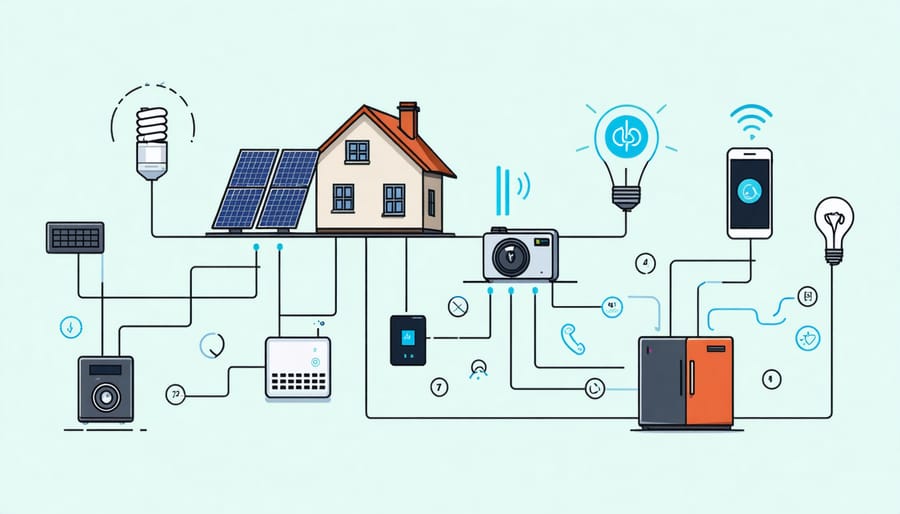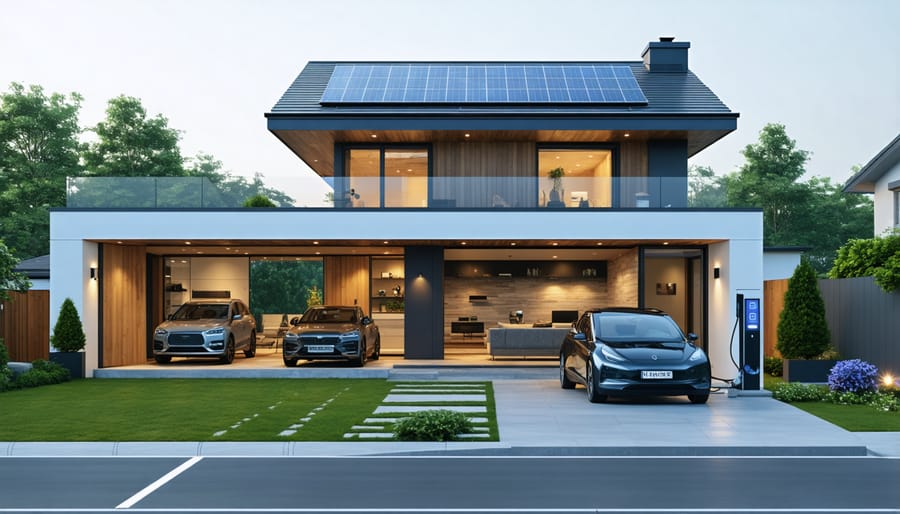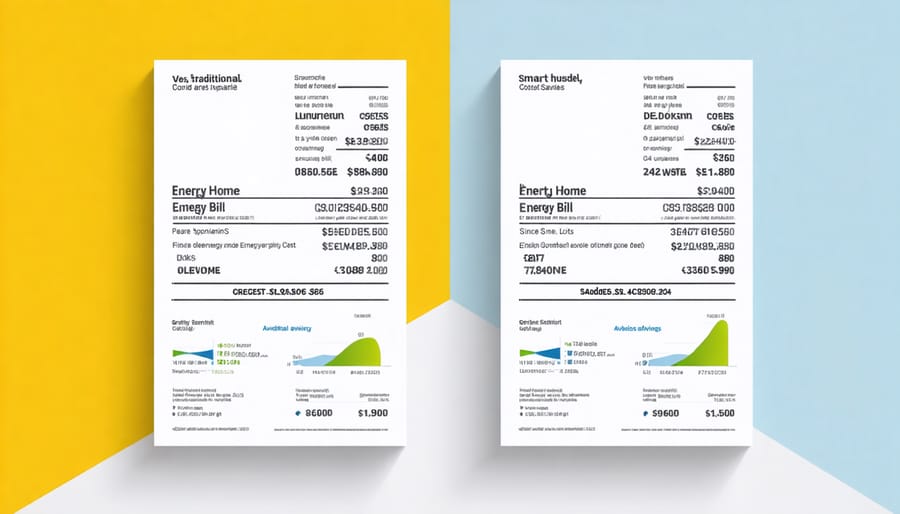Transform your home into an energy-efficient powerhouse with smart energy management systems that seamlessly connect your heating, lighting, and appliances. Modern integrated energy systems slash utility bills by up to 30% while enhancing comfort through intelligent automation. Gone are the days of juggling multiple controls and apps – today’s integrated solutions create a unified ecosystem that optimizes energy use based on your daily routines and preferences.
Imagine your home automatically adjusting temperature zones, dimming lights in empty rooms, and scheduling appliance usage during off-peak hours, all while generating clean solar power and storing excess energy for later use. This isn’t futuristic technology – it’s available right now, helping thousands of homeowners reduce their carbon footprint and take control of their energy costs.
Whether you’re building new or upgrading your existing home, integrated energy systems offer a practical path to sustainable living without sacrificing convenience. The initial investment typically pays for itself within 3-5 years through reduced energy costs, increased property value, and available tax incentives.
What Makes a Home Energy System ‘Smart’?

Core Components of Smart Home Energy
The heart of any smart home energy system lies in three key components that work together seamlessly. Smart meters are your home’s energy gateway, providing real-time data about your electricity usage and helping you track consumption patterns throughout the day. Think of them as your personal energy detective, spotting unusual spikes and potential waste.
Smart controllers act as the brain of your system, automatically adjusting your home’s energy use based on your preferences and daily routines. These clever devices can turn off unused appliances, dim lights when natural sunlight is available, and even adjust your heating and cooling systems for optimal efficiency.
Monitoring devices are your eyes and ears, offering detailed insights through user-friendly apps and dashboards. They show you exactly where your energy is going and suggest ways to reduce consumption. You can check your energy use from anywhere, receive alerts about unusual activity, and even compare your usage with similar homes in your area.
Together, these components create a responsive, efficient system that helps you save energy without sacrificing comfort. The best part? Most modern systems are designed to be user-friendly, so you don’t need to be tech-savvy to reap the benefits.
Communication Networks
Think of your integrated energy system as a well-coordinated team where every player needs to communicate effectively. The communication network is like the nervous system of your smart home, allowing your solar panels, battery storage, smart thermostat, and other devices to work together seamlessly.
Most modern systems use WiFi, Zigbee, or Z-Wave protocols to keep all components talking to each other. Your smart meter constantly sends usage data to your energy management system, while your solar inverter reports real-time power generation. This ongoing conversation helps your system make smart decisions, like storing excess solar power in batteries during sunny days or reducing your HVAC usage during peak rate hours.
The heart of this network is usually a central hub or gateway that coordinates all these conversations. It’s like a translator that helps different devices speak the same language, even if they’re from different manufacturers. Many systems now also connect to your smartphone, letting you monitor and control everything through a user-friendly app – perfect for checking your energy usage or adjusting settings while you’re away from home.
Making Your Home Energy System Work Together
Smart Appliance Integration
Modern homes are becoming increasingly connected, and smart appliance integration is at the heart of this transformation. Your major appliances – from refrigerators and washing machines to dishwashers and HVAC systems – can now communicate with your home’s energy management system, creating a more efficient household.
Getting started is easier than you might think. Many new appliances come with built-in WiFi capabilities and companion apps that let you monitor their energy usage in real-time. By connecting these devices to your home network, you can track exactly how much power each appliance uses and when they’re most active.
The real magic happens when these appliances work together with your energy system. Your smart washing machine can automatically run during off-peak hours when electricity rates are lower. Your smart thermostat can adjust your home’s temperature based on your daily routine and energy prices. Even your refrigerator can delay its defrost cycle to avoid peak energy usage times.
To make the most of this integration, look for appliances with Energy Star certification and smart grid compatibility. These features ensure your devices can participate in demand response programs, potentially earning you rebates from your utility company while helping to balance the power grid.
Remember to regularly update your appliances’ firmware and security settings to keep your connected home safe and running smoothly.
Energy Storage Solutions
Energy storage is a game-changer in modern home energy management, and home battery storage solutions are leading the charge. Think of these systems as your home’s personal energy bank, storing excess power when it’s abundant and delivering it when you need it most.
Today’s battery systems come in various sizes and capacities, perfect for homes of all sizes. They work seamlessly with solar panels, storing surplus energy during sunny days for use during cloudy weather or nighttime. But they’re not just for solar-powered homes – these batteries can also store grid electricity when rates are lower, helping you avoid peak pricing.
What makes these systems truly smart is their ability to learn your energy usage patterns. They can automatically decide when to store power and when to use it, maximizing your savings and efficiency. During power outages, they act as reliable backup systems, keeping essential appliances running without interruption.
The best part? Modern battery systems are compact, safe, and require minimal maintenance. Many come with user-friendly apps that let you monitor your energy storage and usage in real-time, giving you complete control over your home’s energy management. While the initial investment might seem significant, the long-term savings and peace of mind make it a worthwhile addition to any integrated energy system.

Renewable Energy Integration
Integrating renewable energy sources into your home’s energy system is a game-changer for both the environment and your wallet. The key to success lies in smart solar energy integration and thoughtful system design.
Start by installing solar panels on your roof or property, ensuring they’re positioned to capture maximum sunlight throughout the day. Modern systems come with smart inverters that automatically convert solar power into usable electricity for your home. These inverters communicate with your home’s energy management system to optimize power distribution.
Beyond solar, consider adding other renewable sources like small wind turbines or geothermal systems if your property and local regulations allow. The beauty of an integrated system is that it can seamlessly switch between these various power sources based on availability and demand.
Battery storage systems are essential components, storing excess energy generated during peak production times for use during nights or cloudy days. Smart controllers monitor your energy production and consumption patterns, automatically adjusting to maximize efficiency and minimize waste.
The best part? Many modern systems come with user-friendly apps that let you track your energy production and usage in real-time, helping you make informed decisions about your home’s energy consumption while reducing your carbon footprint.
Real Benefits for Your Home
Energy Cost Savings
Integrated energy systems can significantly reduce your monthly utility bills in several meaningful ways. By coordinating multiple energy sources and consumption points, these smart systems optimize your home’s energy usage around the clock.
The most immediate savings come from automated temperature control. Smart thermostats learn your schedule and preferences, adjusting heating and cooling to run only when needed. This alone can cut your HVAC costs by 10-15% annually. When connected to smart blinds and lighting systems, the savings multiply as natural light and heat are strategically used to maintain comfort.
Energy monitoring features help you identify power-hungry appliances and suggest optimal usage times. For example, running your dishwasher or laundry during off-peak hours can save 30-40% on electricity rates in areas with time-of-use pricing. The system can automatically schedule these tasks for you.
Solar integration brings another layer of savings. Smart systems direct solar power to high-demand devices during peak sunlight hours and store excess energy for later use. Some homeowners report cutting their grid electricity consumption by up to 60% through intelligent solar management.
Many utility companies offer additional rebates and incentives for homes with integrated energy systems, recognizing their role in reducing grid strain. Combined with the energy-saving features, most households see a return on their investment within 2-4 years through reduced utility bills.
Keep in mind that actual savings vary based on your home’s size, local climate, and energy rates. However, most homeowners report monthly utility bill reductions of 20-30% after implementing a comprehensive integrated energy system.

Comfort and Convenience
Imagine walking into your home on a sweltering summer day to find it perfectly cooled, or waking up to a warm, cozy house on a chilly winter morning – all without touching a single switch. This is the everyday reality with integrated energy systems, which bring unprecedented comfort and convenience to modern living.
These smart systems learn your daily routines and preferences, automatically adjusting your home’s temperature, lighting, and appliance usage to match your lifestyle. No more fiddling with thermostats or rushing back home to turn off forgotten lights. Your home actively works to maintain your comfort while managing energy use efficiently.
The convenience extends beyond basic automation. Through smartphone apps, you can monitor and control your home’s energy systems from anywhere. Running late from work? Adjust your heating schedule with a few taps. Having guests over? Preset your home to welcome them with perfect lighting and temperature.
What’s particularly appealing is the seamless integration of different components. Your smart blinds can work in harmony with your HVAC system, automatically adjusting throughout the day to maintain optimal indoor temperatures. Motion sensors can detect when you enter or leave rooms, managing lighting and temperature accordingly.
The system can even anticipate your needs based on weather forecasts and historical usage patterns. On unexpectedly hot days, it might pre-cool your home before you return from work, ensuring comfort without wasting energy. During peak rate hours, it can automatically shift energy-intensive tasks to more cost-effective times, all while maintaining your comfort preferences.
Getting Started with Smart Energy Integration
Starting your journey with smart energy integration doesn’t have to be overwhelming. Let’s break it down into manageable steps that will help you create an efficient, money-saving system for your home.
Begin by conducting a home energy audit to identify your current energy usage patterns and potential areas for improvement. This can be as simple as reviewing your utility bills and noting which appliances consume the most power. Many utility companies offer free energy assessments, which can provide valuable insights.
Next, choose a smart home hub that will serve as the brain of your integrated system. Popular options like Google Home, Amazon Alexa, or Apple HomeKit can help you coordinate various smart devices. Make sure the hub you select is compatible with the devices you plan to add to your system.
Start small by installing smart thermostats and LED bulbs. These are typically the easiest components to integrate and offer immediate energy savings. Smart thermostats learn your preferences and automatically adjust temperature settings, while LED bulbs can be programmed for optimal usage patterns.
As you become comfortable with these basics, gradually add more components:
– Smart plugs to control and monitor individual appliances
– Motion sensors to automate lighting
– Smart window treatments to manage natural light and heat
– Energy monitoring systems to track consumption in real-time
Consider investing in renewable energy sources like solar panels once your basic smart system is running smoothly. Many homeowners find that combining solar power with smart energy management creates the most significant cost savings.
Remember to regularly update your system’s software and check device settings to ensure everything works efficiently together. Start with one room or area of your home and expand gradually as you become more confident with the technology. This approach helps you learn as you go and prevents feeling overwhelmed by too many changes at once.
As we’ve explored, integrated energy systems represent a smart investment in your home’s future, offering significant cost savings, improved comfort, and environmental benefits. By combining various energy sources, smart controls, and efficient appliances, you can create a more sustainable and comfortable living space while reducing your monthly bills. Whether you start small with smart thermostats and LED lighting or go all-in with solar panels and home automation, every step toward integration makes a difference. The technology is becoming more accessible and user-friendly each year, making now the perfect time to begin your journey toward a smarter, more efficient home. Take that first step today by assessing your current energy usage and identifying areas where integrated systems could benefit your household the most.
